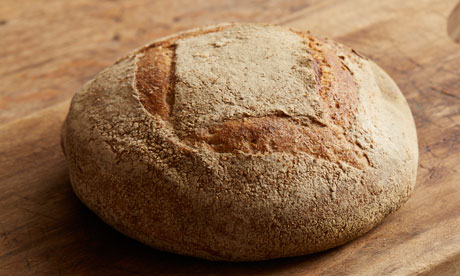
Any discussion of the best bread in London always begins, and often ends, with the sourdough from St John restaurant. The in-house bakery was run for more than a decade by Justin Piers Gellatly – he left earlier this year to work on a variety of projects, including a cookbook. Gellatly started as a chef at St John, but soon found that he was spending his days and then nights with the bakers. "When it comes out of the oven you can hear it crackling," he says. "I just wanted to do it."
Gellatly believes that anyone can make their own bread at home and, for a sourdough loaf, the process begins with a tangy starter (sometimes also known as a mother or leaven). It will take about a week to create, but with care and regular feeding it can last you for the rest of your life. The starter at Poilane in Paris is said to be at least 150 years old.
The ingredients
rhubarb 30g, finely sliced (ideally with a mandoline)
water 100g
organic strong white bread flour 50g
organic wholegrain rye flour 50g
"The rhubarb has natural yeast and acts as a catalyst to start the fermentation," explains Gellatly. "But people also use grapes, tomatoes or sometimes they put in a bit of yoghurt just to start the process: it's a sure-fire way of getting it right. But I've never had one fail with rhubarb." An accurate set of digital scales is essential.
Day One
Place the finely sliced rhubarb in a bowl, then pour on the water and mix the flours so it becomes a thick paste. Leave for 24 hours loosely covered with clingfilm somewhere warm.
Day Two
At around the same time the following day, mix in 50g water, 25g strong white flour and 25g rye flour and leave somewhere warm, again loosely covered. "If there's a little bit of skin on top just mix that in," says Gellatly.
Day Three
Repeat as day two.
Day Four
You should start seeing the beginning of the active fermentation. Then repeat as day three.
Day Five
By now, the starter should be bubbling away and smell tangy. Mix it to combine and then pour 30g of the starter into a larger bowl. Pick out any bits of rhubarb and discard, as the rhubarb has done its job, but it should have all broken down by now anyway. Whisk in 125g water and stir in 30g rye flour, 30g strong wholemeal flour and 80g strong white flour until well incorporated, loosely cover and leave in a warm place.
Discard any leftover starter. "The reason you are doing this is because if you have too much of the original starter in there it will feed on the flour too quickly and it will become dormant by the time you are ready to make bread," says Gellatly. Alternatively, pass it on to someone else to make their own one.
Day Six
Same as day five.
Day Seven
MAKE BREAD! "You can follow whatever sourdough recipe you like," says Gellatly. "One of mine is in The Complete Nose to Tail cookbook, but I'm sure that Paul Hollywood has got one in his book. You can also use the starter in other breads, combined with commercial yeast. So if you wanted a nice sandwich loaf, put some starter in and it will add a nice depth of flavour, some background tanginess. But generally it's for the sourdoughs, the big boys."
Caring for your starter
You now have a living, breathing starter – but don't be scared. "It's very robust," Gellatly assures us. After making a loaf, you will need to replenish your starter with half and half flour and water, in equal quantities to the amount that you took out. If you don't plan to make bread for a while, you can freeze your starter, or even better dehydrate it. Alternatively, just begin this process again from scratch.
Breads, Cakes, Doughnuts, Puddings by Justin Piers Gellatly is published by Fig Tree in spring 2014

